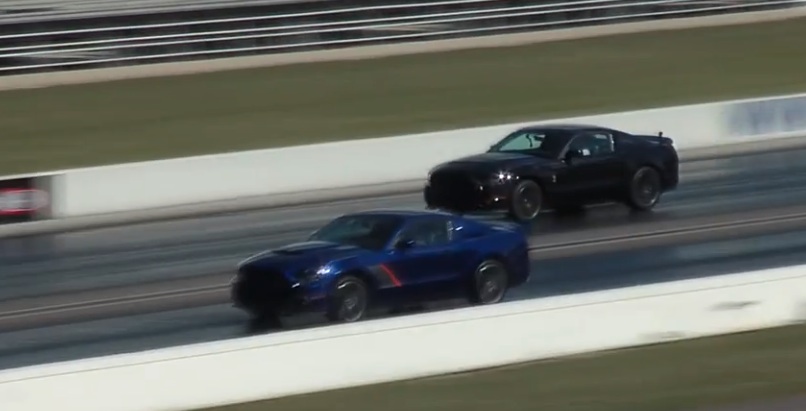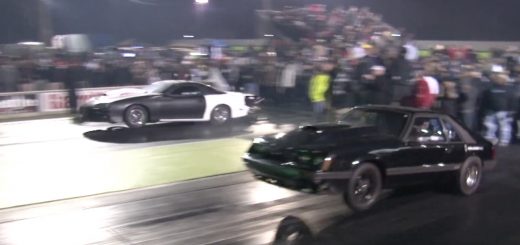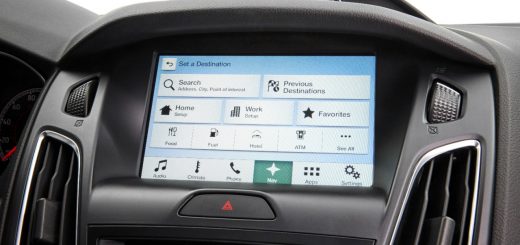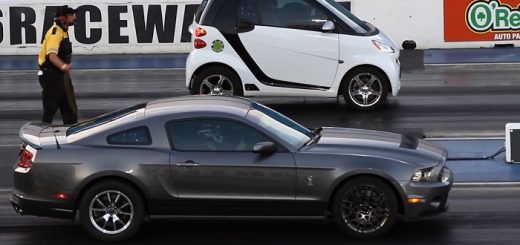Many were surprised that the Mustang Roush Stage 3 Aluminator demolished the Shelby GT500, to the tune of beating it by roughly half a second, in a series of recent hot laps on the drag strip (check the times in the table below). Except for the first run, during which the driver of the Roush had some trouble figuring out the traction control settings. So, how and why did the Roush beat the Shelby by such a wide margin with such a small power advantage?
| RACE | GT500 | ROUSH RS3 ALUMINATOR |
|---|---|---|
| 1 | 12.46 | 13.05 |
| 2 | 12.23 | 11.72 |
| 2 | 12.24 | 11.68 |
To note, the Roush uses the Mustang GT and its 5.0 liter naturally-aspirated and high-revving V8 as a starting point. It’s then supercharged, as is the 5.8 liter Trinity Shelby GT500. So while the power output and the way it is achieved varies between the two cars, what makes the biggest difference is the gear. The Roush makes use of a 3.73 while the GT500 sports a 3.31 (on the 2013 and 2014 model year models) to achieve the 200 mph top speed. And while being able to reach 200 mph is cool and induces all kinds of bragging rights, but something tells us that most GT500 owners would gladly give up the 30-40 mph on the top end to get back the 3.73. Because who, where, and how often would one drive 200 mph? So there’s the more “user-friendly” axle ratio found in the Roush that puts the Shelby at a disadvantage.
Then there’s the issue of the shifter: the unit in the 2013-2014 Shelby is improved over the 2011-2012 model, but it is still far from available aftermarket units that are much more precise and communicative. And the Roush seems to sport an aftermarket shifter.
Disadvantaged by the inferior axle and the stock shifter, the Shelby loses to the Roush. But the story of these two cars doesn’t end there. What the video doesn’t show is the price of the two cars. The 2014 Shelby GT500 starts at $54,800 with the standard 662 horsepower, 631 kb-ft. of torque, as well as the following list of awesome equipment:
- Tremec 6-speed manual transmission
- Brembo 15″ vented front rotors with 6-piston front calipers
- 19″ x 9.5″ front end and 20″ x 9.5″ rear Forged Aluminum Wheels
- Launch Control
Again, all that starts at $54,800.
The Roush Stage 3 Aluminator, however, is a Mustang GT with an aftermarket supercharger, 20 inch wheels, upgraded suspension, and Cooper Zeon RS3-S tires that allow it to pull lateral forces in excess of 1.02 Gs on the skid pad. The car also sports 6-piston brakes, and costs around $60,000, but it’s still missing all the Shelby-specific goodies (such as launch control), styling, interior equipment.
All that is to say that it might be a good idea to save the $7,000 by buying the GT500, use the money to hit up a driving school, and maybe add a better shifter to the Shelby, and then cut a faster time on the drag and on the track than the Roush (and others). But if there’s one thing that’s great about being able to pick between the from-the-factory Shelby and the kind-of-sort-of-aftermarket Roush, it’s the power of choice — which is (almost) always a nice thing to have.














Comments